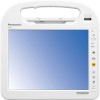Panasonic CF-H1CEKRZ6M User Manual - Page 93
Technical Information, Network Connections and Communications Software, Regarding Windows XP
 |
View all Panasonic CF-H1CEKRZ6M manuals
Add to My Manuals
Save this manual to your list of manuals |
Page 93 highlights
Technical Information 93 Network Connections and Communications Software Close the communications software before using the power saving function. z If the power saving function (standby or hibernation) is activated while communications software is used, the network con- nection may be interrupted, or the performance may be adversely affected. In this case, restart the computer. z In a network environment, set the [System standby] and [System hibernates] settings to [Never]. Click [start] - [Control Panel] - [Performance and Maintenance] - [Power Options] - [Power Schemes]. Regarding Windows XP You can select the Classic view of Control Panel or the Classic Start menu. You can also change the way a user logs on or off. This manual explains using the Windows XP default setting (not Classic view or Classic Start menu etc.). z Windows Update You can update to the latest patches and service packs for Windows with the following menus. Click [start] - [All Programs] - [Windows Update]. Do not apply "Driver Updates" even if a message to update a driver appears. If a driver update is required, contact your technical support office. z If the message "Your computer might be at risk" is displayed Select (red icon) on the notification area and make the appropriate settings. The Windows Security Center regularly gives you notice so that you can make the optimum settings. This is not an error message and you can use the computer. However, making appropriate measures is recommended to reduce the risk of virus and other attacks. Using the Windows Associated Files The Windows files included in the retail version of the Windows CD-ROM for OS are contained in the following folders: c:\windows\docs, c:\windows\dotnetfx, c:\windows\i386, c:\windows\support, c:\windows\valueadd















